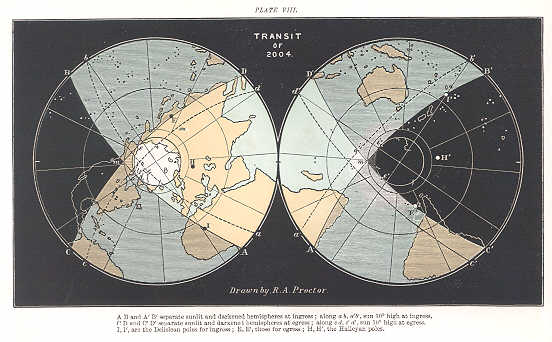|
PHaST and the Transit of Venus
PHaST Preparations
|
The transit of Venus is a rare event which has not been
seen for nearly 122 years. The last transits were in 1874 and
1882.
Only very limited observations of the transit
of Venus in H-alpha were made in 1874 (and perhaps in
1882).
Peter Abrahams
reports that G.L. Tupman observed the first contact
of the transit of 1874 as a member of the
British expedition to Hawaii using a spectroscope set up
to observe prominences. He also reports that Pietro Tacchini
of Palermo Observatory observed the 1874 transit from
Muddapur, India using a spectroscope with a wide slit before
second contact.
The spectrohelioscope, Lyot
filter, interference filter or Fabry-Perot etalon (all
modern methods of observing the Sun in H-alpha light)
had not yet been invented in 1882.
I will be using the PHaST telescope
to observe the transit
of Venus in H-alpha from Dubai in the United Arab Emirates.
I hope to make high-cadence observations of the ingress and
egress phases of the transit.
The 2004 Transit
The 2004 transit occurs on June 8. The locations where it
can be observed are seen here in this drawing.
 Visibility of the June 8, 2004 transit of Venus from Richard
Proctor's 1882 book
Transits of Venus.
The light colored region indicates where the whole transit is visible,
while the gray regions are where the transit is in progress at
sunrise or sunset. The black region is where the transit cannot
be seen at all. Notice how only part of the coastline of
Antarctica and Greenland is shown; that's because the rest was unknown
in 1882.
Visibility of the June 8, 2004 transit of Venus from Richard
Proctor's 1882 book
Transits of Venus.
The light colored region indicates where the whole transit is visible,
while the gray regions are where the transit is in progress at
sunrise or sunset. The black region is where the transit cannot
be seen at all. Notice how only part of the coastline of
Antarctica and Greenland is shown; that's because the rest was unknown
in 1882.
As you can see, California is in the black region so the
transit is not visible from here.
On the other hand, Dubai is perfectly placed for the transit.
Weather statistics indicate that it is very likely to be clear.
Dubai transit information from the
USNO server
is shown below.
Local time in Dubai is UTC + 4 hours. UT1 is based on the rotation
of the Earth, while UTC (Coordinated Universal Time) is atomic time
(TAI) corrected to within 0.9
seconds of UT1 by the use of leap seconds. Civil time is based on
UTC. The location in Dubai
given by the coordinates is most likely that of Fort Dubai, which is
now the Dubai Museum.
Transit of Venus of 2004 June 08
Dubai
Location: E 55°16'48.0", N25°15'08.0", 5m
(Longitude referred to Greenwich meridian)
Sun's Position Angular
UT1 Altitude Azimuth Angle Separation
h m s ° ° ° '
Transit Begins 5:18:06.9 49.1 83.6 116.8 16.2
Ingress Interior Contact 5:37:07.0 53.4 85.1 119.9 15.3
Least Angular Distance 8:20:16.7 87.6 192.9 ----- 10.5
Egress Interior Contact 11:03:22.6 52.3 275.3 213.2 15.3
Transit Ends 11:22:18.4 48.1 276.8 216.3 16.2
Solar Semidiameter: 15' 45.4"
Semidiameter of Venus: 0' 28.9"
What will the transit look like? A movie of the
transit of 1882 as seen in white light can be found
here. The observations were made by David Todd at the site of
Lick Observatory. The movie was made from his digitized plates
by Anthony Misch and Bill Sheehan of Lick Observatory
last year. However,
what the complete transit will look like in H-alpha no one
really knows. We can get some idea from this
BBSO movie
of the 1999 transit of Mercury, but Venus will appear
much larger. Venus also has an atmosphere, so it's unclear
what it will look like before first contact when it will be
seen against the chromosphere. If there happens to be
a prominence in the right place it could be very interesting
indeed.
Some images of Dubai.
On to the transit day itself.
For more information about the transit of Venus, see
this site.
This Way to the Egress!
Back to PHaST page.
Back to John Varsik's home page.

Comments:
John Varsik
varsik@bbso.njit.edu
Last modified: January 12, 2005.
 Visibility of the June 8, 2004 transit of Venus from Richard
Proctor's 1882 book
Transits of Venus.
The light colored region indicates where the whole transit is visible,
while the gray regions are where the transit is in progress at
sunrise or sunset. The black region is where the transit cannot
be seen at all. Notice how only part of the coastline of
Antarctica and Greenland is shown; that's because the rest was unknown
in 1882.
Visibility of the June 8, 2004 transit of Venus from Richard
Proctor's 1882 book
Transits of Venus.
The light colored region indicates where the whole transit is visible,
while the gray regions are where the transit is in progress at
sunrise or sunset. The black region is where the transit cannot
be seen at all. Notice how only part of the coastline of
Antarctica and Greenland is shown; that's because the rest was unknown
in 1882.